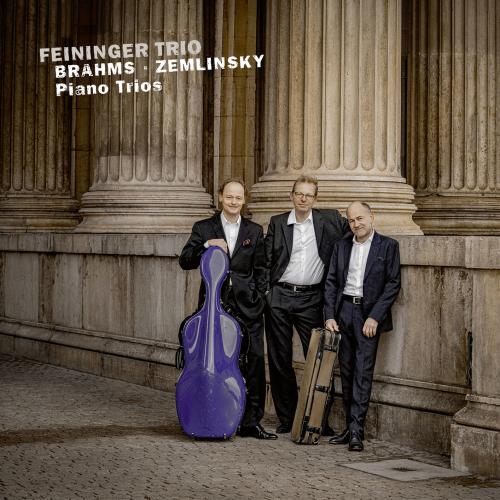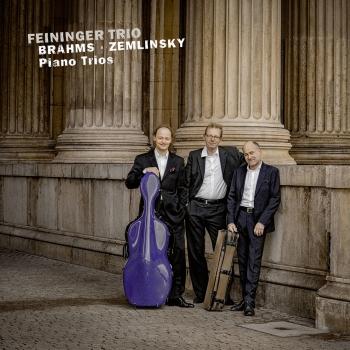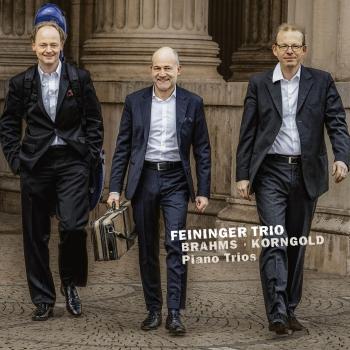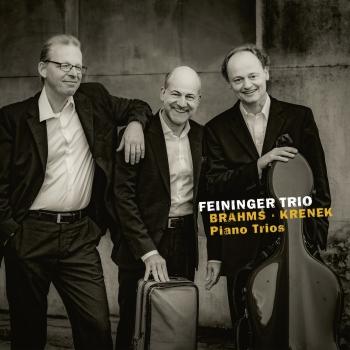
Brahms & Zemlinsky: Piano Trios Feininger Trio
Album info
Album-Release:
2018
HRA-Release:
18.06.2021
Label: CAvi-music
Genre: Classical
Subgenre: Chamber Music
Artist: Feininger Trio
Composer: Alexander von Zemlinsky (1871-1942), Johannes Brahms (1833-1897)
Album including Album cover Booklet (PDF)
- Johannes Brahms (1833 - 1897): Piano Trio No. 3 in C Minor, Op. 101:
- 1 Brahms: Piano Trio No. 3 in C Minor, Op. 101: I. Allegro energico 07:07
- 2 Brahms: Piano Trio No. 3 in C Minor, Op. 101: II. Presto non assai 03:31
- 3 Brahms: Piano Trio No. 3 in C Minor, Op. 101: III. Andante grazioso 04:30
- 4 Brahms: Piano Trio No. 3 in C Minor, Op. 101: IV. Allegro molto 05:27
- Alexander von Zemlinsky (1871 - 1942): Piano Trio in D Minor, Op. 3:
- 5 Zemlinsky: Piano Trio in D Minor, Op. 3: I. Allegro ma non troppo 13:44
- 6 Zemlinsky: Piano Trio in D Minor, Op. 3: II. Andante – Pocco mosso con fantasia 08:07
- 7 Zemlinsky: Piano Trio in D Minor, Op. 3: III. Allegro 05:20
Info for Brahms & Zemlinsky: Piano Trios
In its recording cycle, the Feininger Trio is pairing each of the three piano trios written by Brahms with a work by another Viennese composer: Alexander Zemlinsky, Ernst Krenek, and Erich Wolfgang Korngold, respectively. Brahms’s three piano trios are among the genre’s crowning achievements, and the members of the Feininger Trio were interested in exploring how the piano trio genre developed in the master’s wake.
Younger composers drew on Brahms’s legacy while opening a new window to Modernism and the 20th century, and that was the main criterion in choosing the three pairings. Biographical similarities among Korngold, Krenek, and Zemlinsky in their early years also played a major role in the Feininger Trio’s selection. Despite major stylistic differences, a red thread in their the three composers’ lives connects them all with Brahms.
The connection was strong. As Alexander Zemlinsky put it, young composers attempted to outdo one another by writing in a vein as Brahmsian as possible. Young Zemlinsky knew Brahms and enjoyed the older composer’s support. He was not Brahms’s pupil, but Zemlinsky’s early Piano Trio op. 3 has much in common with Brahms.
It is more widely known as a clarinet trio: in 1896, Zemlinsky submitted it to a competition organized by the Vienna Tonkünstlerverein which required a chamber music work “using at least one wind instrument”.
Feininger Trio:
Adrian Oetiker, piano
Christoph Streuli, violin
David Riniker, cello
Feininger Trio
In 2005, Adrian Oetiker (piano), Christoph Streuli (violin) and David Riniker (cello) formed the Feininger Trio. They named it after painter, designer and Bauhaus co-founder Lyonel Feininger (1871-1956), whose former atelier in the Berlin district of Zehlendorf was located in the vicinity of the room where the musicians now rehearse. Having known one another since their studies, the three musicians had gathered experience in the meantime as chamber musicians in other formations. All three of them wanted to apply that experience to an intense, prolonged study of the piano trio, a genre which possesses a rich, wide-ranging repertoire. They started by mastering the Classical and Romantic core repertoire, particularly the piano trios of Brahms and Dvoˇrák. At the same time they pursued a particular interest in Modernism (Ives, Zemlinsky, Korngold). The current release featuring Czech piano trio masterpieces is dedicated to the memory of the great violinist Josef Suk (1929-2011).
Booklet for Brahms & Zemlinsky: Piano Trios














